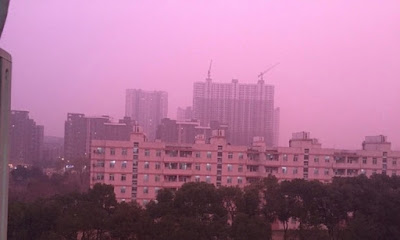 |
| Nanjing sunset, when the purple twilight and dense smog combined to give the appearance of a purple haze. Photograph: Weibo |
Photographs appearing to show one of China’s most famous cities
shrouded in a spectacular violet mist went viral on Wednesday, as
millions of citizens choked on the country’s latest bout of toxic smog.
The fluorescent purple haze that engulfed Nanjing – reportedly the
result of a pollution-tinged sunset – was at one point the second most
talked-about topic on Weibo, China’s answer to Twitter.
“Who can explain what has happened to the sky?” wrote one concerned
Weibo user, as tens of thousands of people posted comments on the
phenomenon.
“It’s the new, grape-flavoured smog!” replied another.
Even Xinhua, China’s official news agency, weighed in, posting photographs of the unusual lilac vista on its Twitter account alongside the headline: “Pink smog?”
Some reacted angrily, claiming the Chinese media was viewing the
country’s pollution crisis through rose-tinted glasses and failing to
challenge Beijing over its failure to stop the smog.
“The government has not taken effective action to control the smog,
and we have to pay for it with our health,” one Weibo user fumed.
“You see hazardous pollution across the whole country,” the commenter
added. “I do not know what percentage of us will suffer respiratory
disease, but why doesn’t the media criticise [the government over this] …
rather than using it as entertainment?”
Nanjing’s Modern Express newspaper
tried to calm its alarmed readers. It said the lavender-coloured skies
had been caused by the combination of a sunset’s glow and a spike in
pollution rather than a specific pollutant.
Liu Hongnian, a Nanjing University scientist, told the newspaper smog
came in only three shades: white, grey and brown. Pink skies did not
represent a new threat to the city’s residents. “People do not need to
be afraid.”
Pollution levels in Nanjing
on Tuesday and Wednesday were more than 10 times higher than those
deemed safe by the World Health Organisation, with many schools
cancelling outdoor activities.
Further north the situation was even more dramatic, if less pink.
In Beijing, which declared its first ever smog red alert earlier this month, environmental monitoring stations reported “hazardous” levels of airborne particulates such as PM2.5.
The entire province of Hebei declared its own pollution red alert
on Tuesday, forcing 11 heavily industrialised cities into virtual
shutdown. Factories were told to suspend activities while schools and
nurseries were closed.
Back in Nanjing, internet users wondered whether the pink skies over China’s former capital represented some kind of omen.


No comments:
Post a Comment